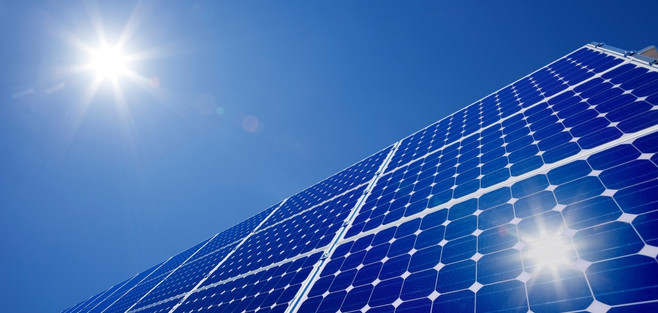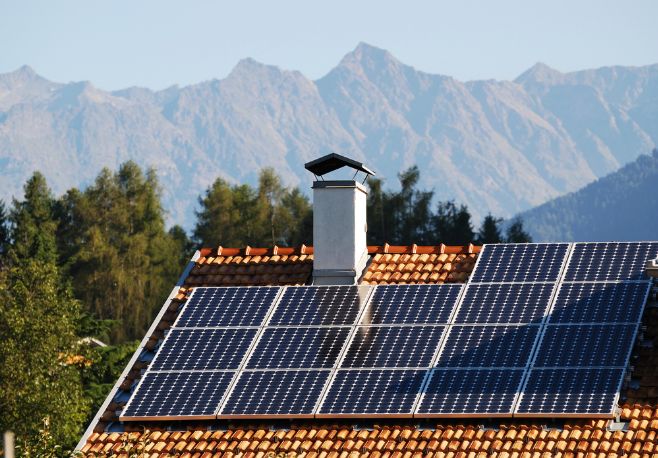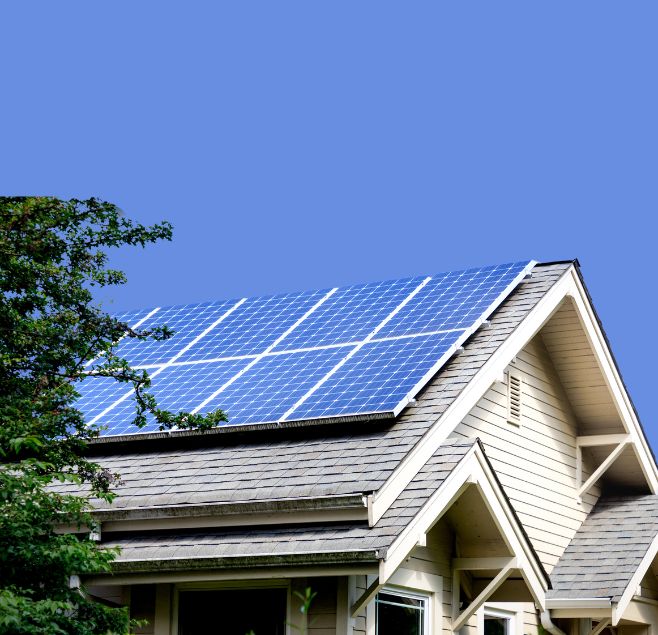Are you concerned about ever-increasing energy bills? Do you worry about your impact on the environment? If so, you're probably looking into renewable energy and the possibility of a hybrid solar installation.
But which type do you go for? And how much do you know about each one? Maybe you've heard of solar thermal panels, and perhaps you've even learned about the more recent solar photovoltaic type. Now, there's a third option: the hybrid solar panel system.
So, what is this new development, how is it different from the others, and is it a good choice?
If you need expert help, Skylamp Solar in Stratford-upon-Avon is here to guide you.

Basically, it's solar PV and thermal combined.
We'll back up a bit here and explain briefly what these two are before we go on.
Thermal solar panels create hot water from sunlight. These are the oldest types of panels, although they have been upgraded over the years. Essentially, heat from the sun is absorbed by solar cells. This warms up a special liquid (usually water and glycol) that is piped to a coil within a hot water tank.
Photovoltaic cells in the panels are lined with a semiconductor. When sunlight hits these cells, it knocks off electrons from the atoms, creating an electrical charge. This charge is collected and sent to your home as usable energy, or stored in a battery for use when the panels don't generate electricity (usually at night). Any excess energy can be sold to an energy supplier if you opt to include a solar battery.
Both are great ways of managing the spiralling gas and electricity bills, and both are better for the environment as they lower our reliance on fossil fuels.
A hybrid solar system combines these, providing you with hot water and electricity.
Confusingly, other sources in Stratford-upon-Avon talk about hybrid solar systems that don't include solar thermal. Basically, these are solar PV systems with an upgraded solar inverter that intelligently switches the power supply between battery storage, the panels, and the grid's power lines.
So, if you use up all the power in your battery, the inverter will automatically draw power from the grid.
In reality, it should be called a hybrid inverter rather than a hybrid solar system.
Always double-check which type of system you are buying and what you're getting for your money! Skylamp Solar goes through the details with each customer to ensure that there's no confusion.
These systems, called solar photovoltaic thermal (shortened to PVT or PV-T) combine the two perfectly in one neat unit.
Hybrid solar panels contain PV cells that work by sending solar power to the inverter, which converts it into electricity. They also have solar collectors from the solar thermal system connected to pipes running through the structure. This makes the entire system more compact, which is great if you have limited roof space.
The solar collectors generate your domestic hot water supply while the PV cells provide power for your home (or business).


Any type of renewable energy source has its positives and negatives, and hybrid solar systems are no exception.
Here are some points worth considering:
One of the key attractions is that it potentially offers energy independence - or partial independence at the very least. With solar PVT, you'll have more control over your gas and electric bills, and your finances.
The main issue at the moment is that the technology is still fairly new. Some hybrid systems won't be able to generate enough energy during winter, so you'll probably need a primary energy source from your utility company.
As these systems are upgraded, many homeowners with a hybrid solar PV system might choose to go off-grid; they'll disconnect from the electrical grid and rely entirely on their own power supply. It's entirely your choice whether to remain connected or not, although if you want to sell extra energy back to the grid, you'll need to stay connected.
Also, you need to monitor your power consumption carefully if you decide to opt out of grid power. Make sure you have some other form of backup power if your solar battery runs out and your panels aren't producing energy (i.e. at night).
One of the problems with solar PV panels is that they work best on cool, sunny days. Overheating in the height of summer can reduce their efficiency and even damage the solar cells. It's estimated that solar PV panels that reach 70-80ºc might experience a decrease in efficiency of up to 25% on a very hot day.
This issue is overcome in a solar PV-T panel as the thermal element draws heat away using a heat exchanger on the back of the panel. This extra heat can be added to your hot water system and your PV system will run much more efficiently.
Investing in a hybrid solar system will probably cost you more than buying a standard PV system.
This is because they are very new to the market; not many solar panel installers have been trained to handle these yet. They are still regarded as a niche product, which can push prices up.
However, if you had been planning to install separate PV and solar thermal systems, then the hybrid system makes more sense and would save you money. And don't forget, your new solar panels will be much more efficient than if you bought separate systems.
It's also worth bearing in mind that as this product becomes more mainstream, costs will inevitably fall. In addition, it's likely that the government will recognise the benefits of this system and introduce incentives to encourage more home and business owners to install them.
It's likely that the solar thermal element in your hybrid panels won't produce all the hot water you need in the colder months, so you may need to supplement this with a boiler. This is no great surprise and has always been an issue with thermal solar panels.
Even so, there may be a way around this problem by using a heat pump. This will pull the heat out of the panels in the summer, helping them to stay cool and run efficiently in the hot weather, and boost the source temperature for the heat pump in winter, also making it run efficiently!
All modern solar panels are designed to be low-maintenance. There are no moving parts to wear out and these units can last for decades.
However, they will require routine inspection, preferably annually, just to ensure that they are working correctly and at maximum efficiency. It's also a good idea to get them cleaned once in a while. Rainwater will wash away some of the dust and dirt, but bird droppings and dead leaves can be more problematic, reducing the output of PV panels and stopping solar collectors from absorbing the sun's rays.
Contrary to what most people believe, solar panels don't need direct sunlight to work, but they can be affected by dirt and debris on the surface. This needs to be cleaned off to keep them running properly.

As an example, a 4kWp solar PV or solar thermal system in Stratford-upon-Avon might cost between £5,000 and £8,000, whereas a hybrid solar system would be nearer to £10,000. The final cost would depend on the system capacity, the number of panels, the brand, and whether you include a battery backup system.
We can provide you with a clearer estimate if we know all the details, so speak to our team in Stratford-upon-Avon today to find out more. Or check out our blog post entitled “how much does a solar panel installation cost” for a “very rough price estimate”.


Installing solar panels for a hybrid system is the same process as any other type.
Aluminium rails are fastened to the roof using hooks attached to the roof trusses or rafters, and the panels are bolted to these securely.
Electrical wiring will be installed that connects the solar panels to an inverter, and pipes will take the heated liquid to a hot water cylinder.
We would never recommend that anyone try to install solar panels of any kind themselves, but this applies to the hybrid solar system in particular. These are specialised pieces of equipment that must be handled carefully by experts.
At Skylamp Solar in Stratford-upon-Avon, we believe that a solar PVT panel installation is an excellent investment for the future - in the right circumstances.
For example, if you are able to invest in a hybrid solar system that includes a backup battery to store energy, then you could make significant long-term savings.
And with a grid connection, you could sell any leftover energy back to the utility company at a profit under the SEG scheme*, helping you to break even a lot more quickly.
*The Smart Export Guarantee, a scheme that replaced the Feed-in Tariff in 2020. Under this scheme, any excess energy generated by your solar panels and kept in your battery storage can be sold to a participating energy supplier. Each one sets its own rates, so it's worth shopping around.
Heat pumps are also a great addition to this system, as they increase efficiency while reducing your reliance on energy companies.
Finally, while the initial cost of installing solar panels might seem high, these modern innovations are far more robust and don't require a lot of costly maintenance as some did in the past. They have an average lifespan of between twenty-five and forty years!


The fact is that there's never been a better time to invest in solar power, as technology has improved efficiency and lifespan. With the right guidance, you could save money and reduce your carbon footprint in one go.
The experts at Skylamp Solar can help you by offering advice on the best system for your budget and requirements, and by fitting your solar system professionally.
Whether you are interested in a thermal, PV or hybrid solar system, don't hesitate to contact us for advice and support in making your decision. We will guide you in making the right choice for your circumstances and will always advise against anything that we feel would not benefit you.
The future of solar panels is very bright, and power generation through the hybrid solar system is set to soar in the coming years. If you want to take advantage of the benefits, get in touch now to see how you can become a pioneer for hybrid PV-T Systems.
Together, we can all play our part in reducing our impact on the environment in Stratford-upon-Avon by producing greener energy and tackling rising energy prices.
Really the only major difference is the hybrid solar inverter, it's this new part that enables the combination of thermal solar panels and photovoltaic solar panels enabling both heated water and electricity generation.
If you're uncertain, consider what exactly you want; what about an all-in-one hot water and electric solar installation? Do you want to upgrade your existing solar system to include a hybrid inverter? Maybe you like the sound of off-grid systems?
At Skylamp Solar, we believe that a solar PVT panel installation is an excellent investment for the future - in the right circumstances. For example, if you are able to invest in a hybrid solar system that includes a backup battery to store energy, then you could make significant long-term savings.
As an example, a 4kWp solar PV or solar thermal system might cost between £5,000 and £8,000, whereas a hybrid solar system would be nearer to £10,000. The final cost would depend on the system capacity, the number of panels, the brand, and whether you include a battery backup system.